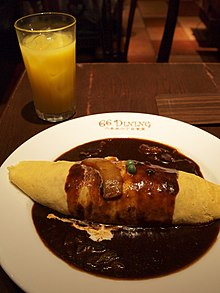Omurice

Omurice or omu-rice (オムライス, Omu-raisu) is an example of contemporary Japanese cuisine (Yōshoku[1]) consisting of an omelette made with fried rice and usually topped with ketchup.[2][3] Omu and raisu being contractions of the words omelette and rice,[4] the name is a wasei-eigo. It is a popular dish both commonly cooked at home and can be found at many western style diners in Japan. The dish was brought to Korea during Japanese occupation,[5] and today it is a fixture on gimbap restaurant menus throughout South Korea, where it is rendered as "오므라이스 (omeuraiseu)" in Hangul.[6] Omurice is also popular in Taiwan, another territory that was occupied by Imperial Japan. Children, in particular, enjoy omurice, and it is often featured on okosama-ranchi or kids' meals.[1]
The dish typically consists of chikin raisu (chicken rice: rice pan-fried with ketchup and chicken) wrapped in a thin sheet of fried egg. The ingredients that flavor the rice vary. Often, the rice is fried with various meats (but typically chicken) and/or vegetables, and can be flavored with beef stock, ketchup, demi-glace white sauce or just salt and pepper. Sometimes, the rice is replaced with fried noodles, yakisoba, instead of fried rice, to make omusoba. A variant in Okinawa is omutako, consisting of an omelet over taco rice. Fried hotdog or Spam are also two popular meats to include in the dish.
Omurice is said to have originated around the turn of the 20th century[4] at a western style restaurant in Tokyo's Ginza district called Renga-tei, inspired by chakin-zushi.[7]
-
Models of various omurice dishes
-
On the inside
See also
References
- ^ a b "Omuraisu (aka omurice or omu rice, Japanese rice omelette)", JustHungry.com.
- ^ Nishimoto, Miyoko (June 1992). "Beyond Sushi: Japanese Cooking in the Great Home-Style Tradition", Vegetarian Times, No. 178. ISSN 0164-8497.
- ^ Paxton, Norbert (2008). The Rough Guide to Korea, p.249. ISBN 978-1-4053-8420-9.
- ^ a b Shimbo, Hiroko (2000). The Japanese Kitchen, p.148. ISBN 1-55832-177-2.
- ^ Sohn, Ho-min (2006). Korean language in culture and society, p.59. ISBN 9780824826949.
- ^ Gail Jennings (October 2005). "Shokudo - An Unlikely Marriage of Comfort Foods". hawaiidiner.com.
- ^ Kishi Asako (March 15, 2002). "NIPPONIA No.20: Omuraisu", Web-Japan.org.
External links
- Setsuko Yoshizuka. "Omu Rice", JapaneseFood.About.com


